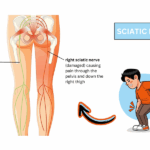That Nagging Ache Isn’t Just “Getting Older”
You wake up in the morning and there it is again — that dull, nagging ache in your lower back. Sometimes it’s sharp. Sometimes it fades in and out. Some days, it feels like you’re carrying invisible bricks in your spine. And no, you’re not imagining it.
Lower back pain is everywhere now. You’re not alone if yours feels worse lately. The causes of lower back pain have shifted — it’s not just about aging or heavy lifting anymore. Our modern habits, tech-filled lives, and stressful routines are all playing a bigger role than we think.
In this post, we’ll break down what’s really causing your lower back pain (even if you’re young, healthy, and active), plus what you can do about it — starting today.
✅ Key Takeaways
-
Lower back pain isn’t always caused by injury or aging — modern habits like sitting too long, poor posture, and stress are major culprits.
-
Sedentary lifestyles weaken core muscles that support your spine.
-
Emotional stress and anxiety can tighten muscles in your back, creating chronic tension.
-
Simple, consistent lifestyle changes (like movement, stretching, and ergonomic adjustments) make a big difference.
📉 Why Lower Back Pain Is More Common Than Ever
1. We Sit. A Lot.
Let’s be real — most of us spend way too much time sitting. Whether it’s on the couch, at a desk, or in the car, sitting for hours on end is now just part of daily life.
But our bodies? They’re not built for it.
Sitting puts extra pressure on the lumbar spine (that’s your lower back). Over time, this can lead to compressed discs, weakened core muscles, and poor circulation. According to a study published in the Journal of Physical Therapy Science, prolonged sitting is directly linked to increased risk of lower back pain — especially without breaks or proper posture.
“Motion is lotion for the spine.” — Common saying among physical therapists
2. Weak Core Muscles = Less Support
Your core isn’t just your abs — it includes deep muscles that wrap around your spine like a natural back brace. If those muscles are weak, your lower back ends up picking up the slack.
And when the back does too much of the work on its own? That’s when pain shows up.
This happens even in people who look fit. Six-pack abs don’t guarantee a strong core. The inner muscles — like the transverse abdominis and multifidus — are the unsung heroes of spinal stability.
😖 Common But Sneaky Causes of Lower Back Pain
3. Poor Posture and “Tech Neck”
Scrolling your phone in bed? Slouched over your laptop at the kitchen table? Over time, these seemingly harmless habits cause your spine to round and your hips to tilt. That pulls on your lower back like a stretched-out rubber band.
Many people develop a condition called anterior pelvic tilt, where the pelvis tips forward due to tight hip flexors and weak glutes. This creates a deep curve in your lower back, leading to pain.
According to the Cleveland Clinic, poor posture is a leading cause of lower back pain in adults under 40.
4. Stress and Emotional Tension
This one surprises people — but emotional stress is a huge contributor to physical pain.
When you’re anxious, overwhelmed, or constantly in “fight-or-flight” mode, your muscles tighten — especially around the shoulders, neck, and lower back. Chronic stress can even change the way your body perceives pain, making minor aches feel intense.
Ever had a “bad back day” after a rough week at work? That’s no coincidence.
5. Lack of Movement and Flexibility
The human body craves movement. When we stop moving often — or only move in the same way — muscles get stiff, joints lose mobility, and the fascia (connective tissue) around muscles gets stuck.
Tight hamstrings, immobile hips, and stiff ankles can all mess with how your spine moves. And when one area gets locked up, the lower back takes the hit.
🧠 Real People, Real Pain
Jen, 38, a busy graphic designer: “I thought it was just bad luck or genetics. But once I started walking daily and doing some gentle stretches, my back pain dropped by 80%.”
Ray, 45, a former construction worker: “After years of lifting heavy stuff, I figured my back was toast. Turned out I was sleeping on a terrible mattress and sitting in a horrible chair. Fixing those made a huge difference.”
🛠️ What You Can Do Today to Ease the Pain
1. Get Up Every 30–60 Minutes
Your back loves variety. Sitting in one spot for too long compresses the spine and stiffens your muscles. Set a timer and just stand, stretch, or walk around briefly every 30–60 minutes. Even 2 minutes helps.
2. Strengthen Your Core Gently
You don’t need crunches — in fact, those can make back pain worse. Focus on exercises that stabilize rather than strain.
Try:
-
Bird-dogs
-
Dead bugs
-
Side planks
-
Bridges
These engage your deep core muscles and teach them to support your spine better.
3. Stretch Your Hips and Hamstrings
Tight hips = angry lower back.
Daily stretches for your:
-
Hip flexors
-
Glutes
-
Hamstrings
-
Piriformis
…can relieve the pull on your spine and restore balance.
4. Upgrade Your Sleep Setup
Poor mattresses and unsupportive pillows often go unnoticed — but they matter. Your spine should stay in a neutral alignment while you sleep.
-
Side sleepers: Use a pillow between your knees.
-
Back sleepers: Try a small pillow under your knees.
-
Stomach sleepers: Consider switching positions.
5. Do a Posture Check
Whether you’re working from home or scrolling on your phone, check in with your posture:
-
Are your shoulders rounded forward?
-
Is your lower back slouched?
-
Is your neck jutting out?
Use ergonomic tools if needed — a lumbar cushion, laptop stand, or adjustable chair can save your spine.
🌿 Natural Aids and Mind-Body Tools
Movement is Medicine
The CDC recommends at least 150 minutes of moderate activity per week to reduce musculoskeletal pain and improve function. Even a brisk walk counts.
Try Gentle Yoga or Pilates
Both focus on alignment, breath, and core strength — a perfect combo for back relief. Even 10 minutes a day can improve flexibility and reduce tension.
Harvard Health notes that yoga can be more effective than medication for some chronic back pain cases.
Practice Deep Breathing or Meditation
Relaxing your nervous system can release the unconscious tension that builds up in your back. Start with 5 slow belly breaths, or use a free meditation app.
🚨 When to See a Doctor
Most lower back pain improves with rest, movement, and self-care. But you should see a doctor if:
-
Pain is severe or lasts more than a few weeks
-
You experience numbness, tingling, or weakness in the legs
-
Pain radiates below the knee
-
You lose bladder or bowel control (this could signal a serious issue)
Lower back pain isn’t just a “you problem” — it’s a modern problem. And it’s not always caused by something dramatic like a fall or an accident. Often, it’s the quiet habits — too much sitting, not enough movement, stress, bad posture — that silently stack up until your back says “enough.”
The good news? Your body is incredibly adaptable. With small daily tweaks — a little movement, better posture, mindful stretching — you can start to feel better. You don’t have to live with constant discomfort.
And if today’s the day you stand up, stretch, and take your first deep breath — your lower back will thank you.
🙋♀️ FAQ: Causes of Lower Back Pain
1. Can stress really cause lower back pain?
Yes. Emotional stress leads to muscle tension, especially in the lower back. It also increases pain sensitivity.
2. What are the most common causes of lower back pain in young adults?
Poor posture, weak core muscles, sedentary habits, and tech overuse are top causes.
3. Can sitting too much hurt my back even if I exercise daily?
Yes. Long sitting sessions compress your spine. Even active people can develop pain from too much sitting.
4. What’s the best sleeping position for lower back pain?
Sleeping on your side with a pillow between your knees or on your back with a pillow under your knees can help.
5. How can I strengthen my core safely if I have back pain?
Avoid crunches. Start with stabilization moves like bird-dogs, side planks, and pelvic tilts.
6. Does weight gain cause lower back pain?
Excess weight, especially around the belly, adds stress to your spine and can contribute to pain.
7. Should I rest or move if my back hurts?
Gentle movement is usually better than bed rest. Too much inactivity can make pain worse.
8. Can walking help lower back pain?
Absolutely. Walking improves circulation, strengthens muscles, and eases stiffness.
9. What kind of doctor should I see for chronic lower back pain?
Start with a primary care doctor. They may refer you to a physical therapist, orthopedic specialist, or chiropractor.
10. Is it normal to have lower back pain with no injury?
Yes. Most lower back pain isn’t caused by injury — it often stems from habits, posture, or stress.

